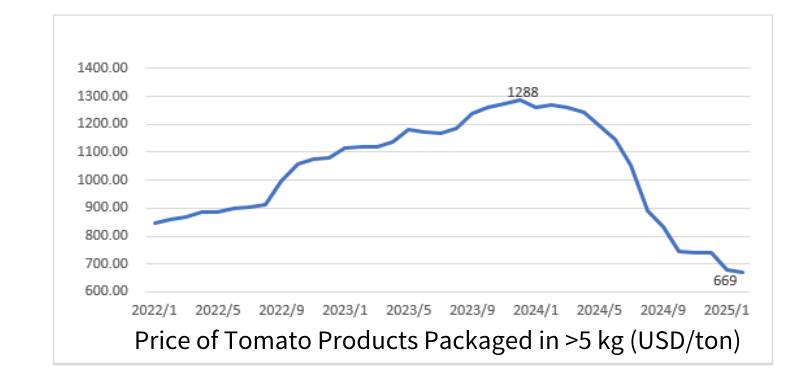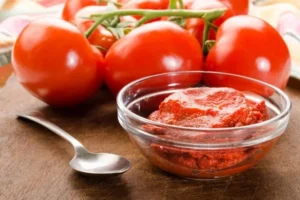I. Current Situation (Up to Early 2025)
- Significant Price Decline
As shown in the chart, the export price of bulk packaged tomato paste (≥5kg) dropped from a peak of $1,288/ton in 2023 to $669/ton by early 2025, a decrease of nearly 50%. - Deteriorating Export Environment
- Global economic slowdown and weakening demand;
- Rising geopolitical risks, including the Russia-Ukraine war and Red Sea conflict, causing uncertainty in global trade;
- Excess supply globally: Global tomato processing volume is expected to reach 45.8 million tons in 2024, up 4% YoY and 20% compared to 2022.
China’s processing volume rose sharply to 11 million tons in 2024, a 37% YoY increase and 77% higher than 2022.
- Domestic Industry Pressure
- Over 80% of China’s tomato products rely on exports, making the industry highly vulnerable to external shocks;
- Massive overcapacity due to expansion after previous years’ price surge;
- Raw material prices remain rigid, causing a mismatch between production cost and market price;
- Financial stress has led some producers to offload inventory at low prices, further depressing the market.
Export Price Trend of Large-Pack Tomato Products (January 2022 – March 2025)

Data Source: China Customs
II. Forecast for 2025–2026
A. Short-Term Outlook: Weak Recovery Expected
| Factor | Assessment |
|---|---|
| Global oversupply | Inventories remain high through 2025 |
| Slow global demand | Demand recovery sluggish in key markets |
| Geopolitical instability | Continued uncertainty in logistics/trade |
| Domestic overcapacity | Intense price competition continues |
B. Mid-to-Long Term: Structural Opportunities Emerging
- European Weather Disruptions
- Early 2025 reports show droughts/floods in Spain, Italy, Greece, affecting yields;
- EU production shortfalls could create demand for Chinese exports in substitute markets;
- Non-brand-sensitive markets (Eastern Europe, MENA) may resume imports of Chinese tomato paste.
- Low Prices May Become a Competitive Edge
- With prices at a 5-year low, Chinese exports may regain competitiveness in bulk and food-service channels once global inventories ease.
- Industry Consolidation and Polarization
- Inefficient small players may exit the market;
- Scalable, vertically integrated producers will gain market share;
- Leading enterprises are pivoting toward value-added products (e.g., bottled sauce, flavoring pastes) and domestic retail markets.
III. Price Forecast (Indicative)
| Time Period | Estimated Export Price (USD/ton) | Market Trend |
|---|---|---|
| Q2–Q3 2025 | 650–750 | Market bottom, weak export recovery |
| Q4 2025–Q1 2026 | 750–880 | Modest rebound possible |
| Q2 2026 onward | 880–1,050 | Gradual recovery if global supply stabilizes |
IV. Strategic Recommendations for Chinese Exporters
- Stabilize Production & Control Costs
- Tighten cost control in farming and procurement;
- Avoid overexpansion amid weak margins.
- Tiered Market Strategy
- Focus export efforts on less brand-sensitive regions (Africa, Middle East, Eastern Europe);
- Shift domestic focus to foodservice, e-commerce, and value-added product lines.
- Risk Management
- Closely monitor FX rates, raw material volatility, and shipping risks;
- Secure advance orders or hedge against major cost fluctuations.
- Explore Diversification
- Consider expanding into concentrated paste in small packaging, sauces, or tomato-based health foods to increase value per unit.
- from

